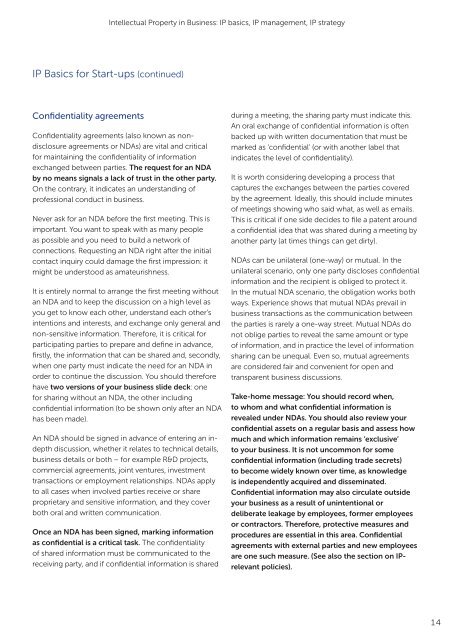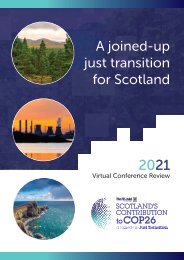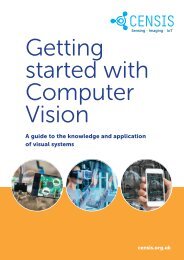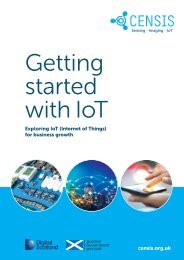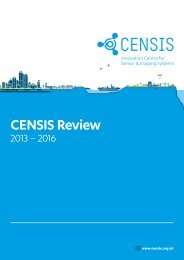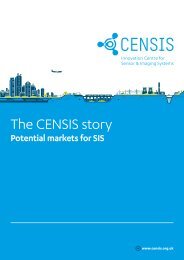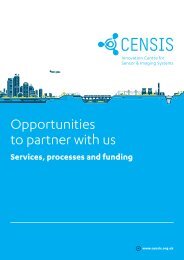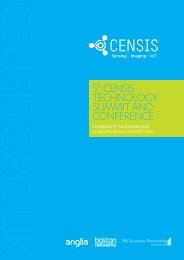CENSIS white paper: Intellectual Property in Business
2023: This CENSIS white paper sets out to make the topic of IP more approachable, less intimidating and more manageable, offering experience-based advice and methods are are designed to help businesses structure their IP- related issues and makes the best of their IP. Covering: The role of IP, IP management during growth, IP strategy for expanding companies and corporates, Business IP Canvas - merging IP with your business model.
2023: This CENSIS white paper sets out to make the topic of IP more approachable, less intimidating and more manageable, offering experience-based advice and methods are are designed to help businesses structure their IP- related issues and makes the best of their IP.
Covering:
The role of IP, IP management during growth, IP strategy for expanding companies and corporates, Business IP Canvas - merging IP with your business model.
You also want an ePaper? Increase the reach of your titles
YUMPU automatically turns print PDFs into web optimized ePapers that Google loves.
<strong>Intellectual</strong> <strong>Property</strong> <strong>in</strong> Bus<strong>in</strong>ess: IP basics, IP management, IP strategy<br />
IP Basics for Start-ups (cont<strong>in</strong>ued)<br />
Confidentiality agreements<br />
Confidentiality agreements (also known as nondisclosure<br />
agreements or NDAs) are vital and critical<br />
for ma<strong>in</strong>ta<strong>in</strong><strong>in</strong>g the confidentiality of <strong>in</strong>formation<br />
exchanged between parties. The request for an NDA<br />
by no means signals a lack of trust <strong>in</strong> the other party.<br />
On the contrary, it <strong>in</strong>dicates an understand<strong>in</strong>g of<br />
professional conduct <strong>in</strong> bus<strong>in</strong>ess.<br />
Never ask for an NDA before the first meet<strong>in</strong>g. This is<br />
important. You want to speak with as many people<br />
as possible and you need to build a network of<br />
connections. Request<strong>in</strong>g an NDA right after the <strong>in</strong>itial<br />
contact <strong>in</strong>quiry could damage the first impression: it<br />
might be understood as amateurishness.<br />
It is entirely normal to arrange the first meet<strong>in</strong>g without<br />
an NDA and to keep the discussion on a high level as<br />
you get to know each other, understand each other’s<br />
<strong>in</strong>tentions and <strong>in</strong>terests, and exchange only general and<br />
non-sensitive <strong>in</strong>formation. Therefore, it is critical for<br />
participat<strong>in</strong>g parties to prepare and def<strong>in</strong>e <strong>in</strong> advance,<br />
firstly, the <strong>in</strong>formation that can be shared and, secondly,<br />
when one party must <strong>in</strong>dicate the need for an NDA <strong>in</strong><br />
order to cont<strong>in</strong>ue the discussion. You should therefore<br />
have two versions of your bus<strong>in</strong>ess slide deck: one<br />
for shar<strong>in</strong>g without an NDA, the other <strong>in</strong>clud<strong>in</strong>g<br />
confidential <strong>in</strong>formation (to be shown only after an NDA<br />
has been made).<br />
An NDA should be signed <strong>in</strong> advance of enter<strong>in</strong>g an <strong>in</strong>depth<br />
discussion, whether it relates to technical details,<br />
bus<strong>in</strong>ess details or both – for example R&D projects,<br />
commercial agreements, jo<strong>in</strong>t ventures, <strong>in</strong>vestment<br />
transactions or employment relationships. NDAs apply<br />
to all cases when <strong>in</strong>volved parties receive or share<br />
proprietary and sensitive <strong>in</strong>formation, and they cover<br />
both oral and written communication.<br />
Once an NDA has been signed, mark<strong>in</strong>g <strong>in</strong>formation<br />
as confidential is a critical task. The confidentiality<br />
of shared <strong>in</strong>formation must be communicated to the<br />
receiv<strong>in</strong>g party, and if confidential <strong>in</strong>formation is shared<br />
dur<strong>in</strong>g a meet<strong>in</strong>g, the shar<strong>in</strong>g party must <strong>in</strong>dicate this.<br />
An oral exchange of confidential <strong>in</strong>formation is often<br />
backed up with written documentation that must be<br />
marked as ‘confidential’ (or with another label that<br />
<strong>in</strong>dicates the level of confidentiality).<br />
It is worth consider<strong>in</strong>g develop<strong>in</strong>g a process that<br />
captures the exchanges between the parties covered<br />
by the agreement. Ideally, this should <strong>in</strong>clude m<strong>in</strong>utes<br />
of meet<strong>in</strong>gs show<strong>in</strong>g who said what, as well as emails.<br />
This is critical if one side decides to file a patent around<br />
a confidential idea that was shared dur<strong>in</strong>g a meet<strong>in</strong>g by<br />
another party (at times th<strong>in</strong>gs can get dirty).<br />
NDAs can be unilateral (one-way) or mutual. In the<br />
unilateral scenario, only one party discloses confidential<br />
<strong>in</strong>formation and the recipient is obliged to protect it.<br />
In the mutual NDA scenario, the obligation works both<br />
ways. Experience shows that mutual NDAs prevail <strong>in</strong><br />
bus<strong>in</strong>ess transactions as the communication between<br />
the parties is rarely a one-way street. Mutual NDAs do<br />
not oblige parties to reveal the same amount or type<br />
of <strong>in</strong>formation, and <strong>in</strong> practice the level of <strong>in</strong>formation<br />
shar<strong>in</strong>g can be unequal. Even so, mutual agreements<br />
are considered fair and convenient for open and<br />
transparent bus<strong>in</strong>ess discussions.<br />
Take-home message: You should record when,<br />
to whom and what confidential <strong>in</strong>formation is<br />
revealed under NDAs. You should also review your<br />
confidential assets on a regular basis and assess how<br />
much and which <strong>in</strong>formation rema<strong>in</strong>s ‘exclusive’<br />
to your bus<strong>in</strong>ess. It is not uncommon for some<br />
confidential <strong>in</strong>formation (<strong>in</strong>clud<strong>in</strong>g trade secrets)<br />
to become widely known over time, as knowledge<br />
is <strong>in</strong>dependently acquired and dissem<strong>in</strong>ated.<br />
Confidential <strong>in</strong>formation may also circulate outside<br />
your bus<strong>in</strong>ess as a result of un<strong>in</strong>tentional or<br />
deliberate leakage by employees, former employees<br />
or contractors. Therefore, protective measures and<br />
procedures are essential <strong>in</strong> this area. Confidential<br />
agreements with external parties and new employees<br />
are one such measure. (See also the section on IPrelevant<br />
policies).<br />
14


